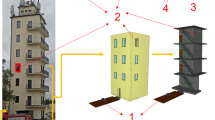Abstract
Pigs are subjected to intensive environment control and management for higher productivity due to their sensitivity to climatic variation, which affects their growth. The aim of the current work is to numerically model the air speed and temperature in a forced ventilation piggery to achieve optimum environmental control. This work can also help to identify problems in the design of piggeries and offer suggestions for improvements. A steady two-dimensional numerical model including the effect of buoyancy, turbulence and heat generated by the pigs was solved using the computational fluid dynamics software Fluent, using the integral volume method. Air speed and temperature inside the piggery and at the pigs’ level were predicted for three different locations of ventilation opening, inlet velocities in the range (0.3 - 7 m/s), insulation or no insulation in the external walls, and for 5 °C and 32 °C ambient temperatures.
Similar content being viewed by others
References
Kilgour, N. and Dalton, C., “Livestock Behaviour,” Granada Publishing: London, (1984).
Turner, L. W., Monegue, H. J., Gates, R. S. and Lindemann, M.D., “Fan, Sprinkler, and Sprinkler Plus Fan Systems for Cooling Growing-Finishing Swine,” American Society of Agricultural Engineers, 3, p.14, (1997).
Fritschen, R D., Underdahl, N.R. and DeShazer, J. A., “The Effect of Building Type Management and Percent Slatted Floor on Performance and Health Characteristics in Pigs,” Proceedings of the International Livestock Environment Symposium, pp 144–156, (1974).
Usry, J.L., Turner, L.W., Bridges, T.C. and Nienaber, J.A., “Modelling the Physiological Growth of Swine Part III: Heat Production and Interaction with Environment,” Transactions of the American Society of Agricultural Engineers, 35, No. 3, pp1035–1042, (1992).
Albright, L.D., “Slotted Inlet Baffle Control Bases on Inlet Jet Momentum Numbers,” Transactions of the American Society of Agricultural Engineers, pp 1764–1768, (1989).
Axaopoulos, P., Panagakis, P., Pitsilis, G. and Kyritsis, S., “AGRISIM: A PC User-Friendly Transient Simulation Program for Growing-finishing Swine Buildings,” American Society of Agricultural Engineers, 10, No 5, pp 735–738, (1994).
Axaopoulos, P., Panagakis, P. and Kyritsis, S., “Computer Simulation Assessment of the Thermal Microenvironment of Growing Pigs Under Summer Conditions,” Transactions of the American Society of Agricultural Engineers, 35, No. 3, pp 1005–1009, (1992).
“Fluent Incorporated”. FLUENT 4.4 User’s Guide, 1–4, 2nd Edition, (1997).
Ogilvie, J.R., Barver, E.M. and Randall, J.M., “Floor Air Speeds and Inlet Design in Swine Ventilation Systems,” Transactions in Agriculture, 33, No 1, pp 255–259, (1990).
Gandner, J.A.A., Dunkin, A.C. and Lloyd, L.C., “Pig Production in Australia,” Butterworths Pty Ltd, (1990).
Author information
Authors and Affiliations
Rights and permissions
About this article
Cite this article
Mossad, R. Numerical modelling of air temperature and velocity in a forced ventilation piggery. J. of Therm. Sci. 9, 211–216 (2000). https://doi.org/10.1007/s11630-000-0053-7
Issue Date:
DOI: https://doi.org/10.1007/s11630-000-0053-7




